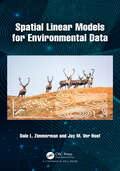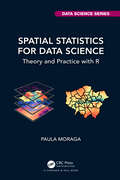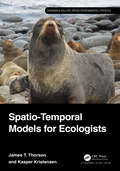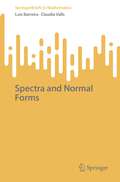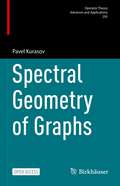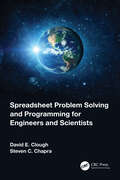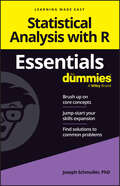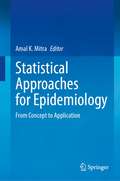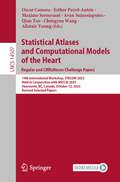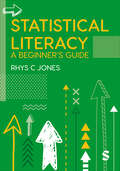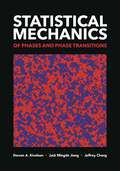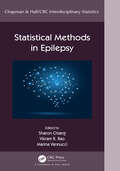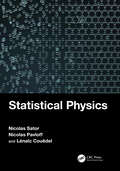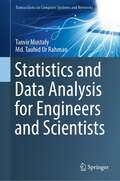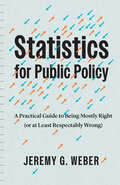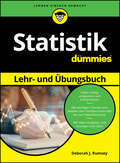- Table View
- List View
Spatial Linear Models for Environmental Data (Chapman & Hall/CRC Applied Environmental Statistics)
by Dale L. Zimmerman Jay M. Ver HoefMany applied researchers equate spatial statistics with prediction or mapping, but this book naturally extends linear models, which includes regression and ANOVA as pillars of applied statistics, to achieve a more comprehensive treatment of the analysis of spatially autocorrelated data. Spatial Linear Models for Environmental Data, aimed at students and professionals with a master’s level training in statistics, presents a unique, applied, and thorough treatment of spatial linear models within a statistics framework. Two subfields, one called geostatistics and the other called areal or lattice models, are extensively covered. Zimmerman and Ver Hoef present topics clearly, using many examples and simulation studies to illustrate ideas. By mimicking their examples and R code, readers will be able to fit spatial linear models to their data and draw proper scientific conclusions. Topics covered include: Exploratory methods for spatial data including outlier detection, (semi)variograms, Moran’s I, and Geary’s c. Ordinary and generalized least squares regression methods and their application to spatial data. Suitable parametric models for the mean and covariance structure of geostatistical and areal data. Model-fitting, including inference methods for explanatory variables and likelihood-based methods for covariance parameters. Practical use of spatial linear models including prediction (kriging), spatial sampling, and spatial design of experiments for solving real world problems. All concepts are introduced in a natural order and illustrated throughout the book using four datasets. All analyses, tables, and figures are completely reproducible using open-source R code provided at a GitHub site. Exercises are given at the end of each chapter, with full solutions provided on an instructor’s FTP site supplied by the publisher.
Spatial Statistics for Data Science: Theory and Practice with R (Chapman & Hall/CRC Data Science Series)
by Paula MoragaSpatial data is crucial to improve decision-making in a wide range of fields including environment, health, ecology, urban planning, economy, and society. Spatial Statistics for Data Science: Theory and Practice with R describes statistical methods, modeling approaches, and visualization techniques to analyze spatial data using R. The book provides a comprehensive overview of the varying types of spatial data, and detailed explanations of the theoretical concepts of spatial statistics, alongside fully reproducible examples which demonstrate how to simulate, describe, and analyze spatial data in various applications. Combining theory and practice, the book includes real-world data science examples such as disease risk mapping, air pollution prediction, species distribution modeling, crime mapping, and real state analyses. The book utilizes publicly available data and offers clear explanations of the R code for importing, manipulating, analyzing, and visualizing data, as well as the interpretation of the results. This ensures contents are easily accessible and fully reproducible for students, researchers, and practitioners. Key Features: Describes R packages for retrieval, manipulation, and visualization of spatial data Offers a comprehensive overview of spatial statistical methods including spatial autocorrelation, clustering, spatial interpolation, model-based geostatistics, and spatial point processes Provides detailed explanations on how to fit and interpret Bayesian spatial models using the integrated nested Laplace approximation (INLA) and stochastic partial differential equation (SPDE) approaches
Spatial Statistics for Data Science: Theory and Practice with R (Chapman & Hall/CRC Data Science Series)
by Paula MoragaSpatial data is crucial to improve decision-making in a wide range of fields including environment, health, ecology, urban planning, economy, and society. Spatial Statistics for Data Science: Theory and Practice with R describes statistical methods, modeling approaches, and visualization techniques to analyze spatial data using R. The book provides a comprehensive overview of the varying types of spatial data, and detailed explanations of the theoretical concepts of spatial statistics, alongside fully reproducible examples which demonstrate how to simulate, describe, and analyze spatial data in various applications. Combining theory and practice, the book includes real-world data science examples such as disease risk mapping, air pollution prediction, species distribution modeling, crime mapping, and real state analyses. The book utilizes publicly available data and offers clear explanations of the R code for importing, manipulating, analyzing, and visualizing data, as well as the interpretation of the results. This ensures contents are easily accessible and fully reproducible for students, researchers, and practitioners. Key Features: Describes R packages for retrieval, manipulation, and visualization of spatial data Offers a comprehensive overview of spatial statistical methods including spatial autocorrelation, clustering, spatial interpolation, model-based geostatistics, and spatial point processes Provides detailed explanations on how to fit and interpret Bayesian spatial models using the integrated nested Laplace approximation (INLA) and stochastic partial differential equation (SPDE) approaches
Spatio-Temporal Models for Ecologists (Chapman & Hall/CRC Applied Environmental Statistics)
by James Thorson Kasper KristensenEcological dynamics are tremendously complicated and are studied at a variety of spatial and temporal scales. Ecologists often simplify analysis by describing changes in density of individuals across a landscape, and statistical methods are advancing rapidly for studying spatio-temporal dynamics. However, spatio-temporal statistics is often presented using a set of principles that may seem very distant from ecological theory or practice. This book seeks to introduce a minimal set of principles and numerical techniques for spatio-temporal statistics that can be used to implement a wide range of real-world ecological analyses regarding animal movement, population dynamics, community composition, causal attribution, and spatial dynamics. We provide a step-by-step illustration of techniques that combine core spatial-analysis packages in R with low-level computation using Template Model Builder. Techniques are showcased using real-world data from varied ecological systems, providing a toolset for hierarchical modelling of spatio-temporal processes. Spatio-Temporal Models for Ecologists is meant for graduate level students, alongside applied and academic ecologists.Key Features: Foundational ecological principles and analyses Thoughtful and thorough ecological examples Analyses conducted using a minimal toolbox and fast computation Code using R and TMB included in the book and available online
Spatio-Temporal Models for Ecologists (Chapman & Hall/CRC Applied Environmental Statistics)
by James Thorson Kasper KristensenEcological dynamics are tremendously complicated and are studied at a variety of spatial and temporal scales. Ecologists often simplify analysis by describing changes in density of individuals across a landscape, and statistical methods are advancing rapidly for studying spatio-temporal dynamics. However, spatio-temporal statistics is often presented using a set of principles that may seem very distant from ecological theory or practice. This book seeks to introduce a minimal set of principles and numerical techniques for spatio-temporal statistics that can be used to implement a wide range of real-world ecological analyses regarding animal movement, population dynamics, community composition, causal attribution, and spatial dynamics. We provide a step-by-step illustration of techniques that combine core spatial-analysis packages in R with low-level computation using Template Model Builder. Techniques are showcased using real-world data from varied ecological systems, providing a toolset for hierarchical modelling of spatio-temporal processes. Spatio-Temporal Models for Ecologists is meant for graduate level students, alongside applied and academic ecologists.Key Features: Foundational ecological principles and analyses Thoughtful and thorough ecological examples Analyses conducted using a minimal toolbox and fast computation Code using R and TMB included in the book and available online
Spectra and Normal Forms (SpringerBriefs in Mathematics)
by Luís Barreira Claudia VallsThis book presents the reader with a streamlined exposition of the notions and results leading to the construction of normal forms and, ultimately, to the construction of smooth conjugacies for the perturbations of tempered exponential dichotomies. These are exponential dichotomies for which the exponential growth rates of the underlying linear dynamics never vanish. In other words, its Lyapunov exponents are all nonzero. The authors consider mostly difference equations, although they also briefly consider the case of differential equations. The content is self-contained and all proofs have been simplified or even rewritten on purpose for the book so that all is as streamlined as possible. Moreover, all chapters are supplemented by detailed notes discussing the origins of the notions and results as well as their proofs, together with the discussion of the proper context, also with references to precursor results and further developments. A useful chapter dependence chart is included in the Preface. The book is aimed at researchers and graduate students who wish to have a sufficiently broad view of the area, without the discussion of accessory material. It can also be used as a basis for graduate courses on spectra, normal forms, and smooth conjugacies.The main components of the exposition are tempered spectra, normal forms, and smooth conjugacies. The first two lie at the core of the theory and have an importance that undoubtedly surpasses the construction of conjugacies. Indeed, the theory is very rich and developed in various directions that are also of interest by themselves. This includes the study of dynamics with discrete and continuous time, of dynamics in finite and infinite-dimensional spaces, as well as of dynamics depending on a parameter. This led the authors to make an exposition not only of tempered spectra and subsequently of normal forms, but also briefly of some important developments in those other directions. Afterwards the discussion continues with the construction of stable and unstable invariant manifolds and, consequently, of smooth conjugacies, while using most of the former material.The notion of tempered spectrum is naturally adapted to the study of nonautonomous dynamics. The reason for this is that any autonomous linear dynamics with a tempered exponential dichotomy has automatically a uniform exponential dichotomy. Most notably, the spectra defined in terms of tempered exponential dichotomies and uniform exponential dichotomies are distinct in general. More precisely, the tempered spectrum may be smaller, which causes that it may lead to less resonances and thus to simpler normal forms. Another important aspect is the need for Lyapunov norms in the study of exponentially decaying perturbations and in the study of parameter-dependent dynamics. Other characteristics are the need for a spectral gap to obtain the regularity of the normal forms on a parameter and the need for a careful control of the small exponential terms in the construction of invariant manifolds and of smooth conjugacies.
Spectral Geometry of Graphs (Operator Theory: Advances and Applications #293)
by Pavel KurasovThis open access book gives a systematic introduction into the spectral theory of differential operators on metric graphs. Main focus is on the fundamental relations between the spectrum and the geometry of the underlying graph.The book has two central themes: the trace formula and inverse problems.The trace formula is relating the spectrum to the set of periodic orbits and is comparable to the celebrated Selberg and Chazarain-Duistermaat-Guillemin-Melrose trace formulas. Unexpectedly this formula allows one to construct non-trivial crystalline measures and Fourier quasicrystals solving one of the long-standing problems in Fourier analysis. The remarkable story of this mathematical odyssey is presented in the first part of the book.To solve the inverse problem for Schrödinger operators on metric graphs the magnetic boundary control method is introduced. Spectral data depending on the magnetic flux allow one to solve the inverse problem in full generality, this means to reconstruct not only the potential on a given graph, but also the underlying graph itself and the vertex conditions.The book provides an excellent example of recent studies where the interplay between different fields like operator theory, algebraic geometry and number theory, leads to unexpected and sound mathematical results. The book is thought as a graduate course book where every chapter is suitable for a separate lecture and includes problems for home studies. Numerous illuminating examples make it easier to understand new concepts and develop the necessary intuition for further studies.
Spreadsheet Problem Solving and Programming for Engineers and Scientists
by David E. Clough Steven C. ChapraSpreadsheet Problem Solving and Programming for Engineers and Scientists provides a comprehensive resource essential to a full understanding of modern spreadsheet skills needed for engineering and scientific computations. Beginning with the basics of spreadsheets and programming, this book builds on the authors’ decades of experience teaching spreadsheets and programming to both university students and professional engineers and scientists. Following on from this, it covers engineering economics, key numerical methods, and applied statistics. Finally, this book details the Visual Basic for Applications (VBA) programming system that accompanies Excel. With each chapter including examples and a set of exercises, this book is an ideal companion for all engineering courses and also for self-study. Based on the latest version of Excel (Microsoft Excel for Microsoft 365), it is also compatible with earlier versions of Excel dating back to Version 2013. Including numerous case studies, this book will be of interest to students and professionals working in all areas of engineering and science.
Spreadsheet Problem Solving and Programming for Engineers and Scientists
by David E. Clough Steven C. ChapraSpreadsheet Problem Solving and Programming for Engineers and Scientists provides a comprehensive resource essential to a full understanding of modern spreadsheet skills needed for engineering and scientific computations. Beginning with the basics of spreadsheets and programming, this book builds on the authors’ decades of experience teaching spreadsheets and programming to both university students and professional engineers and scientists. Following on from this, it covers engineering economics, key numerical methods, and applied statistics. Finally, this book details the Visual Basic for Applications (VBA) programming system that accompanies Excel. With each chapter including examples and a set of exercises, this book is an ideal companion for all engineering courses and also for self-study. Based on the latest version of Excel (Microsoft Excel for Microsoft 365), it is also compatible with earlier versions of Excel dating back to Version 2013. Including numerous case studies, this book will be of interest to students and professionals working in all areas of engineering and science.
Statistical Analysis with R Essentials For Dummies
by Joseph SchmullerThe easy way to get started coding and analyzing data in the R programming language Statistical Analysis with R Essentials For Dummies is your reference to all the core concepts about R—the widely used, open-source programming language and data analysis tool. This no-nonsense book gets right to the point, eliminating review material, wordy explanations, and fluff. Understand all you need to know about the foundations of R, swiftly and clearly. Perfect for a brush-up on the basics or as an everyday desk reference on the job, this is the reliable little book you can always turn to for answers. Get a quick and thorough intro to the basic concepts of coding for data analysis in R Review what you've already learned or pick up essential new skills Perform statistical analysis for school, business, and beyond with R programming Keep this concise reference book handy for jogging your memory as you work This book is to the point, focusing on the key topics readers need to know about this popular programming language. Great for supplementing classroom learning, reviewing for a certification, or staying knowledgeable on the job.
Statistical Analysis with R Essentials For Dummies
by Joseph SchmullerThe easy way to get started coding and analyzing data in the R programming language Statistical Analysis with R Essentials For Dummies is your reference to all the core concepts about R—the widely used, open-source programming language and data analysis tool. This no-nonsense book gets right to the point, eliminating review material, wordy explanations, and fluff. Understand all you need to know about the foundations of R, swiftly and clearly. Perfect for a brush-up on the basics or as an everyday desk reference on the job, this is the reliable little book you can always turn to for answers. Get a quick and thorough intro to the basic concepts of coding for data analysis in R Review what you've already learned or pick up essential new skills Perform statistical analysis for school, business, and beyond with R programming Keep this concise reference book handy for jogging your memory as you work This book is to the point, focusing on the key topics readers need to know about this popular programming language. Great for supplementing classroom learning, reviewing for a certification, or staying knowledgeable on the job.
Statistical Approaches for Epidemiology: From Concept to Application
by Amal K. MitraThis textbook provides the basic concepts of epidemiology while preparing readers with the skills of applying statistical tools in real-life situations. Students, in general, struggle with statistical theories and their practical applications. This book makes statistical concepts easy to understand by focusing on real-life examples, case studies, and exercises. It also provides step-by-step guides for data analysis and interpretation using standard statistical software such as SPSS, SAS, R, Python, and GIS as appropriate, illustrating the concepts.Through the book's 23 chapters, readers primarily learn how to apply statistical methods in epidemiological studies and problem-solving. Among the topics covered:Clinical TrialsEpidemic Investigation and ControlGeospatial Applications in EpidemiologySurvival Analysis and Applications Using SAS and SPSSSystematic Review and Meta-Analysis: Evidence-based Decision-Making in Public HealthMissing Data Imputation: A Practical Guide Artificial Intelligence and Machine LearningMultivariate Linear Regression and Logistics Regression Analysis Using SASEach chapter is written by eminent scientists and experts worldwide, including contributors from institutions in the United States, Canada, Bangladesh, India, Hong Kong, Malaysia, and the Middle East. Statistical Approaches for Epidemiology: From Concept to Application is an all-in-one book that serves as an essential text for graduate students, faculty, instructors, and researchers in public health and other branches of health sciences, as well as a useful resource for health researchers in industry, public health and health department professionals, health practitioners, and health research organizations and non-governmental organizations. The book also will be helpful for graduate students and faculty in related disciplines such as data science, nursing, social work, environmental health, occupational health, computer science, statistics, and biology.
Statistical Atlases and Computational Models of the Heart. Regular and CMRxRecon Challenge Papers: 14th International Workshop, STACOM 2023, Held in Conjunction with MICCAI 2023, Vancouver, BC, Canada, October 12, 2023, Revised Selected Papers (Lecture Notes in Computer Science #14507)
by Oscar Camara Esther Puyol-Antón Maxime Sermesant Avan Suinesiaputra Qian Tao Chengyan Wang Alistair YoungThis book constitutes the proceedings of the 14th International Workshop on Statistical Atlases and Computational Models of the Heart, STACOM 2023, as well as the Cardiac MRI Reconstruction Challenge, CMRxRecon Challenge. There was a total of 53 submissions to the workshop. The 24 regular workshop papers included in this volume were carefully reviewed and selected from 29 paper submissions. They deal with cardiac segmentation, modelling, strain quantification, registration, statistical shape analysis, and quality control. In addition, 21 papers from the CMRxRecon challenge are included in this volume. They focus on fast CMR image reconstruction and provide a benchmark dataset that enables the broader research community to promote advances in this area of research.
Statistical Literacy: A Beginner′s Guide
by Rhys Christopher JonesIn an increasingly data-centric world, we all need to know how to read and interpret statistics. But where do we begin? This book breaks statistical terms and concepts down in a clear, straightforward way. From understanding what data are telling you to exploring the value of good storytelling with numbers, it equips you with the information and skills you need to become statistically literate. It also: Dispels misconceptions about the nature of statistics to help you avoid common traps. Helps you put your learning into practice with over 60 Tasks and Develop Your Skills activities. Draws on real-world research to demonstrate the messiness of data – and show you a path through it. Approachable and down to earth, this guide is aimed at undergraduates across the social sciences, psychology, business and beyond who want to engage confidently with quantitative methods or statistics. It forms a reassuring aid for anyone looking to understand the foundations of statistics before their course advances, or as a refresher on key content.
Statistical Literacy: A Beginner′s Guide
by Rhys Christopher JonesIn an increasingly data-centric world, we all need to know how to read and interpret statistics. But where do we begin? This book breaks statistical terms and concepts down in a clear, straightforward way. From understanding what data are telling you to exploring the value of good storytelling with numbers, it equips you with the information and skills you need to become statistically literate. It also: Dispels misconceptions about the nature of statistics to help you avoid common traps. Helps you put your learning into practice with over 60 Tasks and Develop Your Skills activities. Draws on real-world research to demonstrate the messiness of data – and show you a path through it. Approachable and down to earth, this guide is aimed at undergraduates across the social sciences, psychology, business and beyond who want to engage confidently with quantitative methods or statistics. It forms a reassuring aid for anyone looking to understand the foundations of statistics before their course advances, or as a refresher on key content.
Statistical Literacy: A Beginner′s Guide
by Rhys Christopher JonesIn an increasingly data-centric world, we all need to know how to read and interpret statistics. But where do we begin? This book breaks statistical terms and concepts down in a clear, straightforward way. From understanding what data are telling you to exploring the value of good storytelling with numbers, it equips you with the information and skills you need to become statistically literate. It also: Dispels misconceptions about the nature of statistics to help you avoid common traps. Helps you put your learning into practice with over 60 Tasks and Develop Your Skills activities. Draws on real-world research to demonstrate the messiness of data – and show you a path through it. Approachable and down to earth, this guide is aimed at undergraduates across the social sciences, psychology, business and beyond who want to engage confidently with quantitative methods or statistics. It forms a reassuring aid for anyone looking to understand the foundations of statistics before their course advances, or as a refresher on key content.
Statistical Mechanics of Phases and Phase Transitions
by Steven A. Kivelson Jack Mingde Jiang Jeffrey ChangAn engaging undergraduate introduction to the statistical mechanics of phase transitionsStatistical mechanics deploys a powerful set of mathematical approaches for studying the thermodynamic properties of complex physical systems. This textbook introduces students to the statistical mechanics of systems undergoing changes of state, focusing on the basic principles for classifying distinct thermodynamic phases and the critical phenomena associated with transitions between them. Uniquely designed to promote active learning, Statistical Mechanics of Phases and Phase Transitions presents some of the most beautiful and profound concepts in physics, enabling students to obtain an essential understanding of a computationally challenging subject without getting lost in the details.Provides a self-contained, conceptually deep introduction to the statistical mechanics of phases and phase transitions from a modern perspectiveCarefully leads students from spontaneously broken symmetries to the universality of phase transitions and the renormalization groupEncourages student-centric active learning suitable for both the classroom and self-studyFeatures a wealth of guided worksheets with full solutions throughout the book that help students learn by doingIncludes informative appendixes that cover key mathematical concepts and methodsIdeal for undergraduate physics majors and beginning graduate studentsSolutions manual for all end-of-chapter problems (available only to instructors)
Statistical Methods in Epilepsy (Chapman & Hall/CRC Interdisciplinary Statistics)
Epilepsy research promises new treatments and insights into brain function, but statistics and machine learning are paramount for extracting meaning from data and enabling discovery. Statistical Methods in Epilepsy provides a comprehensive introduction to statistical methods used in epilepsy research. Written in a clear, accessible style by leading authorities, this textbook demystifies introductory and advanced statistical methods, providing a practical roadmap that will be invaluable for learners and experts alike.Topics include a primer on version control and coding, pre-processing of imaging and electrophysiological data, hypothesis testing, generalized linear models, survival analysis, network analysis, time-series analysis, spectral analysis, spatial statistics, unsupervised and supervised learning, natural language processing, prospective trial design, pharmacokinetic and pharmacodynamic modeling, and randomized clinical trials.Features: Provides a comprehensive introduction to statistical methods employed in epilepsy research Divided into four parts: Basic Processing Methods for Data Analysis; Statistical Models for Epilepsy Data Types; Machine Learning Methods; and Clinical Studies Covers methodological and practical aspects, as well as worked-out examples with R and Python code provided in the online supplement Includes contributions by experts in the field The handbook targets clinicians, graduate students, medical students, and researchers who seek to conduct quantitative epilepsy research. The topics covered extend broadly to quantitative research in other neurological specialties and provide a valuable reference for the field of neurology.
Statistical Methods in Epilepsy (Chapman & Hall/CRC Interdisciplinary Statistics)
by Sharon Chiang Vikram R. Rao Marina VannucciEpilepsy research promises new treatments and insights into brain function, but statistics and machine learning are paramount for extracting meaning from data and enabling discovery. Statistical Methods in Epilepsy provides a comprehensive introduction to statistical methods used in epilepsy research. Written in a clear, accessible style by leading authorities, this textbook demystifies introductory and advanced statistical methods, providing a practical roadmap that will be invaluable for learners and experts alike.Topics include a primer on version control and coding, pre-processing of imaging and electrophysiological data, hypothesis testing, generalized linear models, survival analysis, network analysis, time-series analysis, spectral analysis, spatial statistics, unsupervised and supervised learning, natural language processing, prospective trial design, pharmacokinetic and pharmacodynamic modeling, and randomized clinical trials.Features: Provides a comprehensive introduction to statistical methods employed in epilepsy research Divided into four parts: Basic Processing Methods for Data Analysis; Statistical Models for Epilepsy Data Types; Machine Learning Methods; and Clinical Studies Covers methodological and practical aspects, as well as worked-out examples with R and Python code provided in the online supplement Includes contributions by experts in the field The handbook targets clinicians, graduate students, medical students, and researchers who seek to conduct quantitative epilepsy research. The topics covered extend broadly to quantitative research in other neurological specialties and provide a valuable reference for the field of neurology.
Statistical Physics
by Nicolas Sator Nicolas Pavloff Lenaic CouedelThis book presents an introduction to the main concepts of statistical physics, followed by applications to specific problems and more advanced concepts, selected for their pedagogical or practical interest. Particular attention has been devoted to the presentation of the fundamental aspects, including the foundations of statistical physics, as well as to the discussion of important physical examples. Comparison of theoretical results with the relevant experimental data (with illustrative curves) is present through the entire textbook. This aspect is facilitated by the broad range of phenomena pertaining to statistical physics, providing example issues from domains as varied as the physics of classical and quantum liquids, condensed matter, liquid crystals, magnetic systems, astrophysics, atomic and molecular physics, superconductivity and many more. This textbook is intended for graduate students (MSc and PhD) and for those teaching introductory or advanced courses on statistical physics. Key Features: A rigorous and educational approach of statistical physics illustrated with concrete examples. A clear presentation of fundamental aspects of statistical physics. Many exercises with detailed solutions. Nicolas Sator is Associate Professor at Sorbonne University, Paris, France. He is a member of the Laboratory of Theoretical Physics of Condensed Matter (LPTMC) and his research focuses on the physics of liquids. Nicolas Pavloff is Professor at Paris-Saclay University, France. He is a member of Laboratoire de Physique Théorique et Modèles Statistiques (LPTMS) and his domain of research is quantum fluid theory. Lénaïc Couëdel is Professor at the University of Sasktchewan, Saskatoon, Canada and researcher at CNRS, France. His research area is plasma physics with a focus on complex plasma crystals.
Statistical Physics
by Nicolas Sator Nicolas Pavloff Lenaic CouedelThis book presents an introduction to the main concepts of statistical physics, followed by applications to specific problems and more advanced concepts, selected for their pedagogical or practical interest. Particular attention has been devoted to the presentation of the fundamental aspects, including the foundations of statistical physics, as well as to the discussion of important physical examples. Comparison of theoretical results with the relevant experimental data (with illustrative curves) is present through the entire textbook. This aspect is facilitated by the broad range of phenomena pertaining to statistical physics, providing example issues from domains as varied as the physics of classical and quantum liquids, condensed matter, liquid crystals, magnetic systems, astrophysics, atomic and molecular physics, superconductivity and many more. This textbook is intended for graduate students (MSc and PhD) and for those teaching introductory or advanced courses on statistical physics. Key Features: A rigorous and educational approach of statistical physics illustrated with concrete examples. A clear presentation of fundamental aspects of statistical physics. Many exercises with detailed solutions. Nicolas Sator is Associate Professor at Sorbonne University, Paris, France. He is a member of the Laboratory of Theoretical Physics of Condensed Matter (LPTMC) and his research focuses on the physics of liquids. Nicolas Pavloff is Professor at Paris-Saclay University, France. He is a member of Laboratoire de Physique Théorique et Modèles Statistiques (LPTMS) and his domain of research is quantum fluid theory. Lénaïc Couëdel is Professor at the University of Sasktchewan, Saskatoon, Canada and researcher at CNRS, France. His research area is plasma physics with a focus on complex plasma crystals.
Statistics and Data Analysis for Engineers and Scientists (Transactions on Computer Systems and Networks)
by Tanvir Mustafy Md. Tauhid RahmanThis textbook summarizes the different statistical, scientific, and financial data analysis methods for users ranging from a high school level to a professional level. It aims to combine the data analysis methods using three different programs—Microsoft Excel, SPSS, and MATLAB. The book combining the different data analysis tools is a unique approach. The book presents a variety of real-life problems in data analysis and machine learning, delivering the best solution. Analysis methods presented in this book include but are not limited to, performing various algebraic and trigonometric operations, regression modeling, and correlation, as well as plotting graphs and charts to represent the results. Fundamental concepts of applied statistics are also explained here, with illustrative examples. Thus, this book presents a pioneering solution to help a wide range of students, researchers, and professionals learn data processing, interpret different findings derived from the analyses, and apply them to their research or professional fields. The book also includes worked examples of practical problems. The primary focus behind designing these examples is understanding the concepts of data analysis and how it can solve problems. The chapters include practice exercises to assist users in enhancing their skills to execute statistical analysis calculations using software instead of relying on tables for probabilities and percentiles in the present world.
Statistics for Public Policy: A Practical Guide to Being Mostly Right (or at Least Respectably Wrong)
by Jeremy G. WeberA long-overdue guide on how to use statistics to bring clarity, not confusion, to policy work. Statistics are an essential tool for making, evaluating, and improving public policy. Statistics for Public Policy is a crash course in wielding these unruly tools to bring maximum clarity to policy work. Former White House economist Jeremy G. Weber offers an accessible voice of experience for the challenges of this work, focusing on seven core practices: Thinking big-picture about the role of data in decisions Critically engaging with data by focusing on its origins, purpose, and generalizability Understanding the strengths and limits of the simple statistics that dominate most policy discussions Developing reasons for considering a number to be practically small or large Distinguishing correlation from causation and minor causes from major causes Communicating statistics so that they are seen, understood, and believed Maintaining credibility by being right (or at least respectably wrong) in every setting Statistics for Public Policy dispenses with the opacity and technical language that have long made this space impenetrable; instead, Weber offers an essential resource for all students and professionals working at the intersections of data and policy interventions. This book is all signal, no noise.
Statistics for Public Policy: A Practical Guide to Being Mostly Right (or at Least Respectably Wrong)
by Jeremy G. WeberA long-overdue guide on how to use statistics to bring clarity, not confusion, to policy work. Statistics are an essential tool for making, evaluating, and improving public policy. Statistics for Public Policy is a crash course in wielding these unruly tools to bring maximum clarity to policy work. Former White House economist Jeremy G. Weber offers an accessible voice of experience for the challenges of this work, focusing on seven core practices: Thinking big-picture about the role of data in decisions Critically engaging with data by focusing on its origins, purpose, and generalizability Understanding the strengths and limits of the simple statistics that dominate most policy discussions Developing reasons for considering a number to be practically small or large Distinguishing correlation from causation and minor causes from major causes Communicating statistics so that they are seen, understood, and believed Maintaining credibility by being right (or at least respectably wrong) in every setting Statistics for Public Policy dispenses with the opacity and technical language that have long made this space impenetrable; instead, Weber offers an essential resource for all students and professionals working at the intersections of data and policy interventions. This book is all signal, no noise.
Statistik Lehr- und Übungsbuch für Dummies (Für Dummies)
by Deborah J. RumseyIhr praktischer Einstieg in die Statistik Statistik ist nicht immer ganz einfach, aber sehr nützlich. Der Schlüssel zum Erfolg heißt: erst verstehen und dann üben, üben, üben. Deborah Rumsey erklärt Ihnen die notwendigen Grundbegriffe und erläutert die wichtigsten statistischen Konzepte. Dabei kommt sie fast ohne Formeln aus und schafft einen Bezug zwischen Theorie und Praxis. Sie lernen die verschiedenen grafischen Darstellungsmöglichkeiten von statistischem Material kennen und erfahren, wie Sie Ihre Ergebnisse richtig auswerten. Mit Übungen zu allen Themengebieten können Sie dann das erlernte Wissen festigen. Sie erfahren Wie Sie brauchbare Daten erheben Wie Sie Diagramme erstellen und interpretieren Wie Sie mit Wahrscheinlichkeitsmodellen komplizierte Fragen schnell beantworten Wie Sie einen Hypothesentest aufstellen und durchführen
